Family : Troglodytidae

Text © Dr. Gianfranco Colombo

English translation by Mario Beltramini
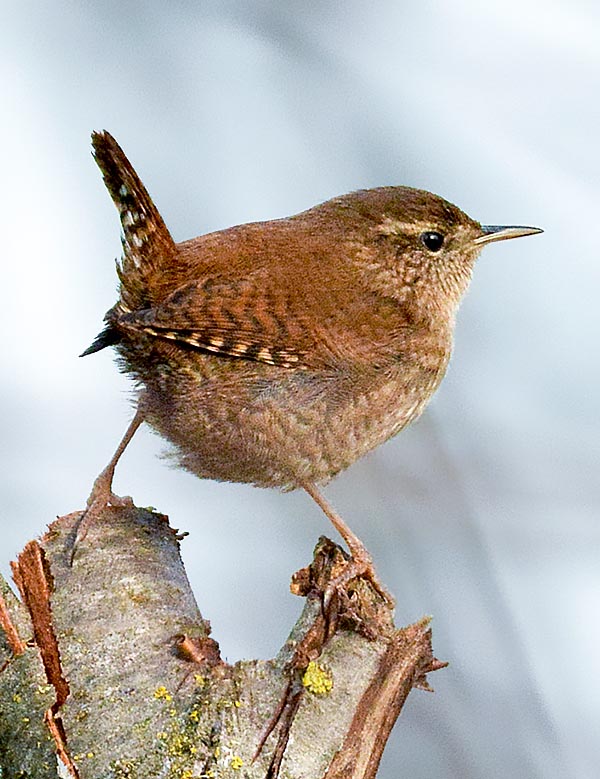
The wren (Troglodytes troglodytes) is the smallest European bird after the goldcrest (Regulus regulus) © Alvaro Dellera
In the British islands, particularly in Ireland, on St. Stephen’s Day it was an old tradition that all juveniles of the village, the face covered with soot, went roaming the countryside beating hedges and bushes with sticks, in pursuit of this tiny bird for killing it and bury later on with a picturesque function.
Once caught, it was then hung on a sprig of holly and carried in procession through the village and shown to all the inhabitants.
It seems then strange that a local tradition so old and confined in places so far from the noble centres of Greek-Roman culture, eventually ends to look exactly like others, arisen thousands of kilometres far away.
If this is classified as an old megalithic Celtic tradition, the same is the very old Greek rite of the Kelidonismos of Rhodes island, maybe coeval, two traditions so distant but with such a strict relation to result practically similar.
Both then concern small and unarmed birds but highly representative of the changing of the seasons and metaphorically, of the annual regeneration of the earth.
If in the Kelidonismos it was matter of Swallows (Hirundo rustica) in the La An Droilin they talked of wrens.
If in the first the boys went from house to house to collect presents in favour of the swallows, in the second the same passed to beg small offerings for celebrating the funeral of the poor wren.
It is then quite easy to connect both with the modern Halloween of the “trick of treat?”.
Small like a wren, you are really a wren! How many times this term has been used to indicate a helpless child or a small animal in need of affection. Who knows how many people have used this term without having ever seen alive this small bird? Actually, it is probably easier to hear its vibrating song rather than observing it in its environment.
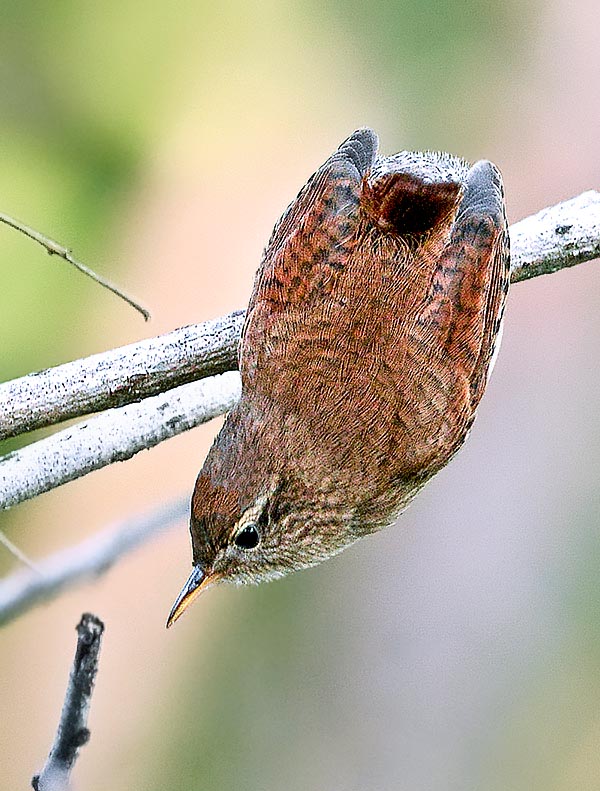
It weighs less than 10 g and does not exceed the 10 cm of length with an about 12 cm wingspan © Dellera
Keeping in mind that it is the second smallest bird of Europe, the first prize being won by a narrow margin by the Goldcrest (Regulus regulus), if we add the environments it frequents and the colour of its livery we have all the conditions for granting the privilege of easily going unnoticed.
Already its scientific name Troglodytes that gets origin from the old Greek “troglo” = cave and “dutes” = inhabitant, term easy to translate in the modern languages in caveman or troglodyte, gives the idea of how much reserved and hidden is its life. In fact, it does not spend its day in caves but the dark corners, the ravines and the hollows of the ground are its choice locations.
Unfortunately, this hypogeal habit it has added to superstitions that never have left in peace the human soul, have rendered the life hard to this small bird.
The human being has always had a strict relationship with the world of the birds seen that also they dance, sing, build up dwellings and have two legs like man and has always imitated them. However, in the same time it has had towards these same animals an ancestral fear that has led him to embrace blindly superstitions and ill-fated interpretations where the same loved little bird was then sacrificed for other purposes.
To immolate a chicken in the Voodoo traditions, to read the intestines by Etruscan haruspices, to hang the heart of an owl to fight blindness, no wonder therefore if our poor small wren together with the harmless Robin (Erithacus rubecula) was often victim of the miners that saw the presence of these birds in the mines as harbinger of impending tragedies.
Finally, always in the old traditions, still since the time of Aesop and Plutarch, the wren or Jenny Wren (female name but used for both sexes) as often is called, is considered as the king of all birds, proving that what it lacks in size it has instead in intelligence.
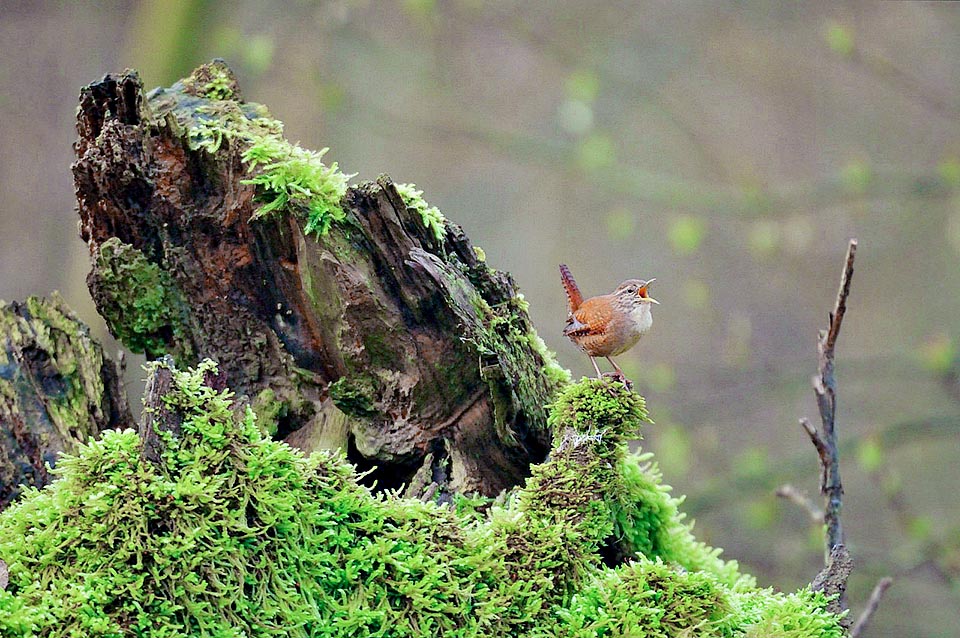
Especially in the reproductive time, it wanders in humid and shady woods, with underwood rich of outcrops and trunks covered by ferns and lichens © Agostino Codazzi
In Italy the wren has an unbelievable number of regional nicknames such as bucafratte, forasiepe, foramacchie, trentapesi, picialì, uccellino del freddo, whilst in various nations the vulgar name refers to its regal position. In Germany is called Zaunkönig = king of the hedges or Schneekönig = king of the snow, in Holland Winterkoning = king of winter, in Japan king of the winds whilst in Spain is Chochin, in France Troglodyte mignon, in Italy Scricciolo and in England Wren.

Here is its house: an almost invisible small hole, well hidden among the stones, from which enters and exits suddenly, rapid as a mouse. Actually, a caveman life as insistently point up the genus and species name: Troglodytes troglodytes from the Greek “troglo” cave and “dutes” = inhabitant © Gianfranco Colombo
Zoogeography
The wren is present all over Europe, in North Africa and in Asia in the cool temperate belt up to Japan.

Although minute, has a strong and shrill song: an unimaginable trill, melodious and unexpected © Gianfranco Colombo
As is typical for those birds having a very vast range, also for the wren have been determined a considerable number of subspecies.
About forty have been classified mainly linked to isolated insular territories or to particularly remote areas of the planet.
Only in Europe and to prove the variety found, we have the Troglodytes troglodytes islandicus typical to Iceland, the Troglodytes troglodytes borealis of the Faroe Islands, the Troglodytes troglodytes zetlandicus of the Shetland Islands, the Troglodytes troglodytes fridariensis always of Shetland but confined in Fair Island, the Troglodytes troglodytes hirtensis endemic to the lost island of St. Kilda in the Hebrides, the Troglodytes troglodytes hebridensis of the Outer Hebrides, the Troglodytes troglodytes indigenus of Great Britain and Ireland, and finally the Troglodytes troglodytes troglodytes of continental Europe.
The wren is sedentary in its temperate ranges whilst is partially errant in the coldest territories.
Morpho-physiology
The livery of the wren is totally dark brown, with a slight and thick blackish spotting that on the tail gets the look of a fine strikethroughs. The chest is slightly paler, with a compact cream colouration and almost completely devoid of striations but on the sides.
On the head it shows a marked whitish superciliary line that stops close to the nape.

Never still, always around looking for the small insects it eats, in a hopping and frantic dance with vertical tail, typical right to almost touch the nape © Gianfranco Colombo
Characteristic of this bird is the position it assumes during its incessant nervous and agitated movements. As they say, it doesn’t stand still even for a moment!
Always well standing on the legs, as if it wanted to appear taller than what it is, keeps always the tail vertically raised, emphasizing, with the usual frantic movement of the body, the jitters that pervade it.
Considered then the habit to stay almost always on the ground and the atavistic mania of entering and getting out from any opening, quick as a rat, it is not difficult to mistake it with a baby mouse.
Then ended for a moment the frantic and genetic frenzy, here it jumps on support even if just a few centimetres from the ground high, always with the tail so much stretched upward to touch the nape, emitting its shrilling song so loud and unlikely for a being “small like a wren”. An unimaginable, pleasant, melodious and unexpected trill.
And yet this small bird weighs less than 10 g, is totally long less than 10 cm and has a wingspan of about 12 cm.
The sound box, should it have it, is by sure the most developed organ!
Ecology-Habitat
During the period of nidification, the wren lives in humid sites, shady, with abundance of underwood, of rocky outcrops covered by lichens, by ferns, of trees with wild ivies clung to the trunk, place usually crossed by small gurgling water streams.
In this environment it can let out its innate passion of exploring every small hollow looking for insects and also of looking for the place where to install the nest.
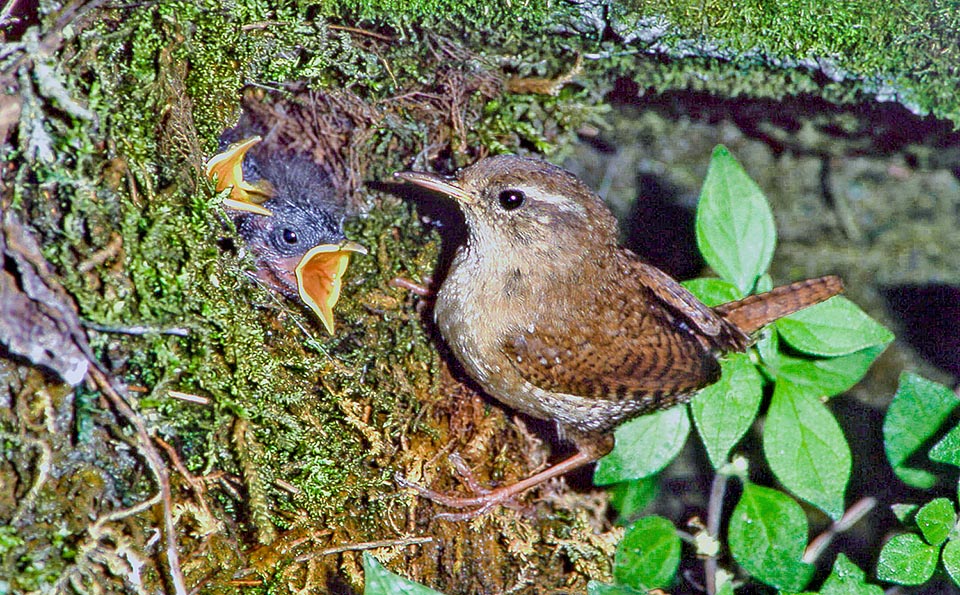
Hungry chicks with mother. The wren male is polygamous. Starts at same time more nests, amassing in cracks it deems suitable between rocks and weeds, mosses, grasses and lichens. The female on duty decorates them laying 5-8 eggs it broods for 2 weeks caring then the chicks © Museo Civico di Lentate sul Seveso
The nest is usually placed in holes on rocks, or tree trunks, in low and very thick bushes close to walls or trees or also in the roots of a capsized trunk.
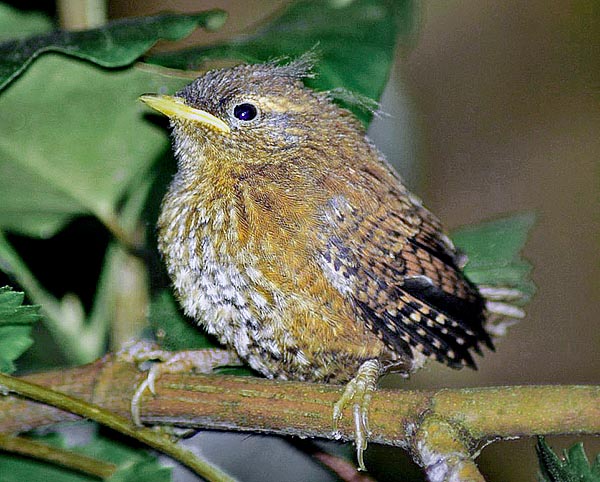
Here one just out from the nest where gets back in the evening with the brothers to spend the night © Agostino Codazzi
It is never located in a high position but rather at level of the ground if not even directly on the same.
It lays 5 to 8, at times up to 10, white cream eggs, finely dotted reddish and that are brooded by the female for about two weeks. In the southern ranges it may nidify a second time.
The chicks come to life bare and blind and only after some days they cover with a fine down that slowly transforms in a juvenile plumage, however very similar to the adults’ one.
The nestlings remain in the nest for some time even if already able to fly off and come back also later on to the nest for weeks to spend there the night.
This habit is widely practiced during the winter when the night temperature falls below zero. The wren succeeds in spending the winter also in very cold and humid sites, spending the days along the banks of the small water streams crossing the woods, entering the cavities looking for the few insects available and spending the night grouping beyond belief in these small nests to maintain the body temperature sufficiently high for overcoming the rigour of the winter nights.
This tiny small bird is subject also to short vertical migrations whereby during the winter willingly goes down in the valley or in the nearby plains to spend the bad season in our gardens, finding food and shelter.

Like various birds also wrens love warming up and disinfect in the sun with open wings on the ground © Alvaro Dellera
Now, two small anedoctes.
In Great Britain the wren enjoys a reputation similar to that of the Robin (Erithacus rubecula) and has been represented in an old coin valid a few decades ago, the farthing, a quarter of penny.

With its very vast range in the temperate zones of North America, Magreb and Eurasia up to Japan, few foes and even two reproductions per year, the Troglodytes troglodytes is not endangered. The mountain populations migrate in the valleys and to fight the cold often more wrens gather in the same den © Gianfranco Colombo
Significant to observe as human being, to exalt the happiness of which often is lacking, mention so frequently that of animals.
Synonyms
Motacilla troglodytes Linnaeus, 1758.
→ To appreciate the biodiversity within PASSERIFORMES please click here.
